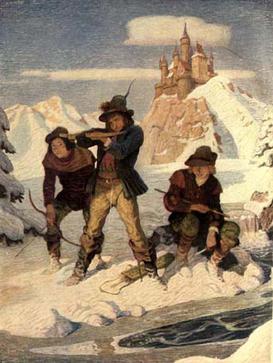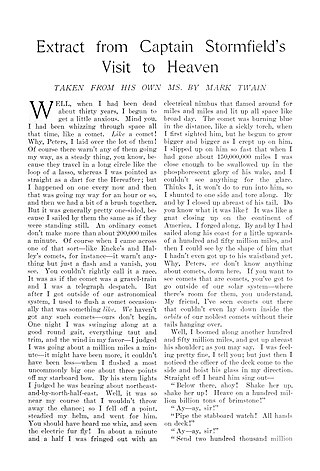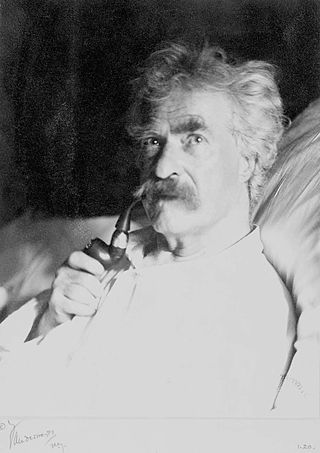
Samuel Langhorne Clemens, known by the pen name Mark Twain, was an American writer, humorist, and essayist. He was praised as the "greatest humorist the United States has produced," with William Faulkner calling him "the father of American literature." Twain's novels include The Adventures of Tom Sawyer (1876) and its sequel, Adventures of Huckleberry Finn (1884), with the latter often called the "Great American Novel." He also wrote A Connecticut Yankee in King Arthur's Court (1889) and Pudd'nhead Wilson (1894) and cowrote The Gilded Age: A Tale of Today (1873) with Charles Dudley Warner.

The Harvard Classics, originally marketed as Dr. Eliot's Five-Foot Shelf of Books, is a 50-volume series of classic works of world literature, important speeches, and historical documents compiled and edited by Harvard University President Charles W. Eliot. Eliot believed that a careful reading of the series and following the eleven reading plans included in Volume 50 would offer a reader, in the comfort of the home, the benefits of a liberal education, entertainment and counsel of history's greatest creative minds. The initial success of The Harvard Classics was due, in part, to the branding offered by Eliot and Harvard University. Buyers of these sets were apparently attracted to Eliot's claims. The General Index contains upwards of 76,000 subject references.

McClure's or McClure's Magazine (1893–1929) was an American illustrated monthly periodical popular at the turn of the 20th century. The magazine is credited with having started the tradition of muckraking journalism, and helped direct the moral compass of the day.

The Mysterious Stranger is a novella by the American author Mark Twain. He worked on it intermittently from 1897 through 1908. Twain wrote multiple versions of the story; each involves a supernatural character called "Satan" or "No. 44", encountering Huckleberry Finn and Tom Sawyer.

John Kendrick Bangs was an American writer, humorist, editor and satirist.

"The Celebrated Jumping Frog of Calaveras County" is an 1865 short story by Mark Twain. It was his first great success as a writer and brought him national attention. The story has also been published as "Jim Smiley and His Jumping Frog" and "The Notorious Jumping Frog of Calaveras County". In it, the narrator retells a story he heard from a bartender, Simon Wheeler, at the Angels Hotel in Angels Camp, California, about the gambler Jim Smiley. The narrator describes him: "If he even seen a straddle bug start to go anywheres, he would bet you how long it would take him to get to wherever he going to, and if you took him up, he would foller that straddle bug to Mexico but what he would find out where he was bound for and how long he was on the road."

"Extract from Captain Stormfield's Visit to Heaven" is a short story written by American writer Mark Twain. It first appeared in print in Harper's Magazine in December 1907 and January 1908, and was published in book form with some revisions in 1909. This was the last story published by Twain during his life.

The Autobiography of Mark Twain is a written collection of reminiscences, the majority of which were dictated during the last few years of the life of American author Mark Twain (1835–1910) and left in typescript and manuscript at his death. The Autobiography comprises a collection of anecdotes and ruminations rather than a conventional autobiography. Twain never compiled the writings and dictations into a publishable form in his lifetime. Despite indications from Twain that he did not want his autobiography to be published for a century, he serialized selected chapters during his lifetime; in addition, various compilations were published during the 20th century. However, it was not until 2010 that the first volume of a comprehensive three-volume collection, compiled and edited by The Mark Twain Project of the Bancroft Library at University of California, Berkeley, was published.

Henry Jackson van Dyke Jr. was an American author, educator, diplomat, and Presbyterian clergyman.

"The Man That Corrupted Hadleyburg" is a piece of short fiction by Mark Twain. It first appeared in Harper's Monthly in December 1899, and was subsequently published by Harper & Brothers in the collection The Man That Corrupted Hadleyburg and Other Stories and Essays (1900). Some see this story "as a replay of the Garden of Eden story", and associate the corrupter of the town with Satan.

The Personal Memoirs of U. S. Grant are an autobiography, in two volumes, of Ulysses S. Grant, the 18th President of the United States. The work focuses on his military career during the Mexican–American War and the American Civil War. The volumes were written in the last year of Grant's life, amid increasing pain from terminal throat cancer and against the backdrop of his personal bankruptcy at the hands of an early Ponzi scheme. The set was published by Mark Twain shortly after Grant's death in July 1885.
"Advice for Good Little Girls" is a humorous essay by Mark Twain, first published in 1865, which lists satirical pieces of advice for how young girls should behave. The Routledge Encyclopedia of Mark Twain called it an early precursor to Twain's satirical youth novels Tom Sawyer and Huckleberry Finn.
The Norrœna Society was an early 20th-century publishing house dedicated to Northern European culture. It published expensively produced reprints of classic 19th-century editions, mostly translations, of Old Norse literary and historical works, Northern European folklore, and medieval literature.

A Horse's Tale is a 1906 novel written by American author Mark Twain, written partially in the voice of Soldier Boy, who is Buffalo Bill's favorite horse, at a fictional frontier outpost with the U.S. 7th Cavalry.

International Publishers is a book publishing company based in New York City, specializing in Marxist works of economics, political science, and history.

Samuel Langhorne Clemens , well known by his pen name Mark Twain, was an American author and humorist. Twain is noted for his novels Adventures of Huckleberry Finn (1884), which has been called the "Great American Novel," and The Adventures of Tom Sawyer (1876). He also wrote poetry, short stories, essays, and non-fiction. His big break was "The Celebrated Jumping Frog of Calaveras County" (1867).
William Gilbert van Tassel Sutphen (1861–1945) was an American playwright, librettist, novelist, and editor, an authority and author of publications on golf, and, eventually, an Episcopalian minister.

Gabriel Wells was a noted bookseller, historian and author. He was one of the most important antiquarian booksellers in America and Britain in the first half of the twentieth century. He was president of the Antiquarian Booksellers' Association in 1930.

Truman W. "True" Williams was an American artist known as the most prolific illustrator to Mark Twain's books and novels. He illustrated the first edition of The Adventures of Tom Sawyer (1876) and was thus the first to visually portray such characters as Tom Sawyer and Huckleberry Finn. He was also sole illustrator of Twain's Sketches, New and Old and primary illustrator of Roughing It and The Innocents Abroad. Working with a number of publishers he also illustrated works by writers Bill Nye, George W. Peck, Joaquin Miller, and others. He was also a notorious drunk, which slowed his work and made him unreliable.
Lester Ralph was an artist who illustrated for several publications.
















